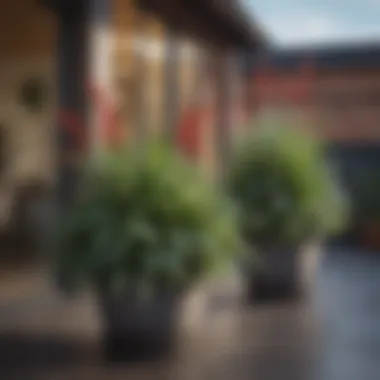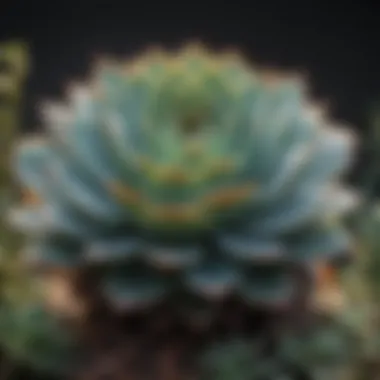Frost Resistant Potted Plants: A Complete Guide


Intro
Frost resistant potted plants play a crucial role in maintaining greenery during colder seasons. In gardening and interior design, they provide versatility and aesthetic appeal, allowing homeowners to enjoy nature without interruption from winter weather. Understanding these plants not only enhances one’s garden experience but also elevates home decor.
The selection of the right potted plants is essential, as it directly influences their ability to withstand frost. This guide delves into appropriate plant choices, care techniques, and design considerations that ensure vibrant indoor and outdoor spaces year-round.
Design Inspirations
Trending Styles
The aesthetic appeal of frost resistant potted plants can be greatly enhanced by current design trends. These styles often favor natural materials and earthy tones. Examples include:
- Minimalism: Fewer, well-placed pots create an uncluttered effect.
- Bohemian: Mixing different pot textures and sizes fosters a vibrant display.
- Contemporary: Sleek, geometric pots paired with bold plant selections make a statement.
Integrating these styles provides a cohesive look that celebrates both plant life and modern design.
Color Palettes
Selecting the right color palette for potted plants can dramatically affect the ambiance of a space. Here are some soothing combinations:
- Soft greys and light greens: These colors enhance a tranquil environment.
- Bold reds and oranges: A dynamic choice that draws attention and creates warmth.
- Earthy browns and muted greens: They provide a nurturing feel and blend seamlessly with outdoor settings.
Using color thoughtfully helps in crafting an environment where plants not only survive but thrive visually.
Maintenance and Upkeep
Seasonal Maintenance Checklist
Regular care is important for the longevity of frost resistant potted plants. Here’s a checklist to follow, especially as seasons change:
- Inspect plants for frost damage: Early detection can save them from greater harm.
- Water appropriately: Modified watering schedules may be necessary in winter months.
- Ensure proper drainage: Good drainage prevents root rot caused by excess moisture.
These steps help to keep plants healthy despite harsher weather conditions.
Cleaning and Organization Tips
A tidy planting area contributes to a better growing environment. Consider these tips for maintaining neatness:
- Regularly wipe pots: Clean pots reduce the risk of diseases and allow for better visibility.
- Group similar plants together: This makes watering and care more efficient.
- Rotate pots periodically: This ensures even sunlight exposure, promoting balanced growth.
Implementing these maintenance strategies can significantly boost both the aesthetic and health of frost resistant potted plants.
"Understanding the nuances of care can drastically enhance the resilience and beauty of your potted plants during frost."
Frost resistant potted plants not only adapt well to colder climates but also add to the overall design sentiments of spaces. By considering trends, colors, and maintenance, homeowners and design enthusiasts can create stunning, resilient displays.
Understanding Frost Resistance
Frost resistance is a crucial concept for anyone involved in gardening or caring for plants, especially in regions where temperatures can drop unexpectedly. The importance of understanding frost resistance lies in its potential to protect and enhance the longevity of potted plants. By recognizing which plants can withstand cold, gardeners can make informed decisions when selecting flora for both outdoor and indoor spaces. This section will shed light on the definition and significance of frost resistance, setting the stage for more detailed discussions later in the article.
Definition of Frost Resistance
Frost resistance refers to the ability of a plant to survive and thrive despite exposure to freezing temperatures. It encompasses various physiological and genetic traits that enable different plant species to endure frost without suffering significant damage.
Plants exhibit frost resistance in several ways. Some species have developed thicker cell walls that act as barriers against ice formation, while others produce antifreeze proteins that lower the freezing point of their cellular fluids. Understanding these mechanisms can help enthusiasts select the most suitable plants for their environments. For instance, if a homeowner lives in an area with cold winters, they may opt for varieties like the winter pansy or hellebores, both known for their frost-hardiness.
Importance of Frost Resistance in Gardening
Understanding frost resistance is not just academic; it has concrete benefits for gardening practices. Here are several reasons why this knowledge is vital:
- Plant Longevity: Choosing frost-resistant plants can prolong their life, preventing the loss that occurs with unsuitably selected flora in colder months.
- Aesthetic Value: A garden or indoor space populated with frost-tolerant species maintains its visual appeal even during winter, ensuring that colors and textures are preserved.
- Resource Optimization: By selecting appropriate plants, gardeners can reduce resource expenditure in terms of maintenance, watering schedules, and protective measures against frost.
"Understanding frost resistance plays a pivotal role in sustainable gardening, allowing you to cultivate a resilient landscape no matter the season."
In summary, grasping the fundamentals of frost resistance is indispensable for gardeners keen on making informed choices. It influences not just plant health but also the aesthetic and practical aspects of gardening, ensuring that both outdoor gardens and indoor plant collections flourish throughout the chilly months.
Selecting Frost Resistant Plants
Selecting frost resistant plants is a critical aspect of ensuring the longevity and health of your garden or indoor plant collection. These plants not only withstand colder temperatures, but they also contribute to the aesthetic appeal of your space. Proper selection minimizes stress on the plants, reduces maintenance efforts, and ultimately supports a vibrant garden throughout the seasons. In this section, we will explore the key criteria for choosing suitable frost resistant potted plants and provide examples of popular options that fit the bill.
Criteria for Choosing Frost Resistant Plants
When contemplating which plants to introduce into your frost sensitive environment, there are several factors to consider:


- Climate Zone: Understand the specific climate zone you are in. Different species have varying tolerance levels to frost, so it's crucial to select plants suited to withstand the unique conditions of your region.
- Hardiness Rating: This rating often determines how much cold a plant can endure. Look for plants rated for USDA Hardiness Zone 5 or lower for optimal frost resistance.
- Growth Habit: Consider the growth habit of potential plants. Plants with a compact structure tend to be more resilient against cold snaps compared to those that spread wide.
- Soil Adaptation: Ensure that the chosen plants can thrive in the soil conditions you can provide. Frost resistant plants often require specific soil types for optimal growth.
- Water Requirement: Assess the water needs of the plants. Some frost resistant plants have lower water requirements, making them easier to care for during the colder months.
These criteria, when taken seriously, ensure that you choose plants with the greatest chance of flourishing despite the challenges of frost.
Examples of Popular Frost Resistant Potted Plants
You have many options when it comes to selecting frost resistant potted plants. Here are some recommended choices:
- Pansies: Known for their vibrant colors and ability to survive light frosts, pansies can provide bright spots in your garden or patio.
- Violas: Similar to pansies, violas are hardy and thrive in cooler conditions, making them perfect for early spring displays.
- Hellebores: These perennial flowers bloom in late winter to spring and are exceptionally hardy, withstanding significant cold.
- Heuchera: With their unique leaf colors and patterns, heuchera is both beautiful and frost resistant, ideal for garden pots.
- Sedums: Sedums, or stonecrops, are succulents that adapt well to frost-prone areas, requiring little water and offering stunning visual texture.
Frost resistant plants not only endure cold but also enhance the beauty of your indoor and outdoor settings.
Choosing the right frost resistant plants can transform how you experience garden aesthetics during colder months. The right selections ensure that your investments in gardening do not go to waste when temperatures drop.
Care Techniques for Frost Resistant Plants
Caring for frost resistant potted plants involves several critical techniques that aim to enhance their resilience against harsh weather conditions. This section focuses on identifiable strategies that improve plant survival and promote growth during the chilly months. The right care techniques not only preserve the health of the plants but also contribute to the overall aesthetic appeal of your indoor or outdoor settings. Understanding these elements is essential for any homeowner or gardening enthusiast determined to maintain a vibrant collection of verdant potted specimens.
Watering Requirements
Watering is a fundamental aspect of plant care, particularly for frost resistant varieties. Understanding the watering needs of these plants can greatly influence their health during winter. In colder months, plants usually require less water due to a decrease in evaporation and growth rates. Overwatering can lead to root rot, especially when the temperatures drop. It is critical to assess the moisture levels in the soil regularly.
- Check soil moisture: Use your finger or a moisture meter to see how damp the soil feels. Water the plant only when necessary.
- Water early in the day: If watering is needed, do this in the morning. This method reduces the risk of frost forming on water droplets overnight.
- Avoid watering frozen ground: If the ground is frozen, refrain from watering as it can create further issues with drainage.
By adhering to these guidelines, your frost resistant plants will have a better chance of thriving in less than ideal conditions.
Soil Considerations
The type of soil used for potted plants plays a significant role in their ability to resist frost damage. Choosing the right soil mixture can improve ventilation, drainage, and moisture retention—all crucial elements for the survival of frost-resistant plants.
- Use well-draining soil: Ensure the used soil allows excess water to escape easily. A mix designed for succulent and cactus plants often works well.
- Consider adding organic matter: Compost can improve soil structure and provide nutrients that aid in plant growth.
- Evaluate soil pH: Frost resistant plants generally prefer a slightly acidic to neutral pH. Regularly check and amend the soil to maintain optimal conditions.
Proper soil management fosters a nurturing environment that helps plants withstand frost exposure better.
Fertilization Needs
Fertilization is another critical component when it comes to maintaining frost resistant plants. During cold months, the growth rate slows, which may lead many to think that fertilization is unnecessary. However, the right type and timing can prepare plants for the upcoming growth cycle effectively.
- Use slow-release fertilizers: These allow nutrients to be available gradually, supporting healthy plant growth even during dormancy.
- Avoid excessive nitrogen: High nitrogen fertilizers can stimulate growth in winter, making plants more susceptible to frost damage. A balanced or phosphorus-rich fertilizer is preferable.
- Fertilize before winter: Apply nutrients prior to frost to help the plants build strength and durability against the cold.
This approach to fertilization equips frost resistant plants better for the challenges posed by low temperatures.
Design Considerations for Potted Plants
When selecting frost resistant potted plants, design considerations play a crucial role in ensuring both aesthetic appeal and plant health. The right design can enhance the longevity of the plants while complementing the overall look of your space. Combining functionality with beauty can lead to an inviting atmosphere, whether in an indoor setting or on a patio.
Choosing the Right Pot
The type of pot you select is foundational to the success of your frost resistant potted plants. Material is a significant factor. Ceramic and terracotta pots, while visually appealing, can be prone to cracking in extreme cold. On the other hand, plastic or fiberglass pots tend to insulate better, reducing the risk of root damage from freezing temperatures.
Size is also vital. A large pot provides more soil, which holds heat better than a smaller one. This heat retention can protect the roots during colder months. Drainage holes should not be overlooked either. Proper drainage minimizes water accumulation, which can freeze and cause root rot or damage.
When selecting pots, consider the color as well. Dark pots absorb more heat, which can be beneficial in winter. Light-colored pots reflect sunlight, keeping plants cooler in summer. Balancing these aspects based on your climate will lead to better outcomes for your frost resistant plants.
Placement and Orientation
Where you place your potted plants matters greatly. Consideration of sunlight exposure and wind patterns is essential. Positioning pots against walls or under eaves can provide some shelter from harsh winds, reducing frost risk. On the other hand, they should be placed where they can receive adequate sunlight during the winter months, as sunlight helps in maintaining soil warmth.
Alternatively, think about orientation towards south-facing areas, as they typically receive more sunlight and warmth during the day. This can help plants thrive and fend off frost effectively.
Regular monitoring of their environment is crucial. Are they receiving enough light? Is there adequate protection from harsh elements? Adjusting the placement of pots based on weather changes can significantly enhance plant health.
By paying close attention to pot selection and strategic placement, you can create an environment where your frost resistant plants not only survive but thrive, adding both beauty and resilience to your space.
"Choosing the right design elements for your potted plants is just as important as selecting the plants themselves. It creates a harmonious balance that promotes growth and beauty."
By understanding the specifics of pot materials, sizes, drainage, and placement, homeowners and gardening enthusiasts can make informed decisions that lead to fulfilling gardening experiences even in the frostiest conditions.
Protective Measures Against Frost
The significance of protective measures in safeguarding frost resistant potted plants cannot be overstated. These strategies are essential for preserving the vitality and aesthetics of plants through harsh winter conditions. Implementing protective techniques minimizes damage and helps ensure that plants thrive when warmer temperatures return. There are various methods to mitigate frost impacts, ranging from physical coverings to strategic placements that enhance resilience.
This section explores three core protective measures: using frost cloths, implementing mulching strategies, and indoor protection methods. Each measure plays a specific role in reinforcing a plant's frost resistance and fosters a favorable environment even in adversity.
Using Frost Cloths


Frost cloths serve as a critical line of defense against freezing temperatures. Lightweight and breathable, these fabrics allow moisture and sunlight to reach the plants while blocking cold winds. When covering potted plants, it is vital to ensure that the cloth is securely draped. Loose cloth may shift and cause damage.
To ensure effectiveness, consider the following:
- Timing: Cover plants before frost is expected. Timing plays a crucial role in minimizing exposure.
- Materials: Opt for specialized frost cloths designed for gardening. They are more effective than standard fabrics.
- Weight: Use rocks or stakes to hold down the edges of the cloth. This prevents it from blowing away
Covering plants overnight is common, but remember to remove the cloth during sunny days. This practice prevents overheating.
Implementing Mulching Strategies
Mulching is another effective measure to protect potted plants from frost damage. A good layer of mulch insulates the soil, maintaining a more consistent temperature around the roots. This layer helps prevent freeze-thaw cycles that can be detrimental to plant health. Using organic materials such as wood chips, straw, or bark provides both insulation and moisture retention.
Key points on mulching include:
- Depth: Ensure the mulch layer is at least 2-3 inches thick. This thickness is essential for proper insulation.
- Application: Apply mulch around the base of the potted plant, avoiding the stem. Preventing decay at the base is important.
- Types: Using organic mulch is highly recommended as it improves soil fertility over time.
Mulching also provides aesthetic value to your garden, blending functionality with beauty.
Indoor Protection Methods
Bringing potted plants indoors during extreme cold is often the most effective strategy. Indoor environments offer consistent temperatures and protection from frost. However, adjusting plant care is vital when moving them indoors.
Here are some tips when using indoor protection:
- Lighting: Ensure the plants receive adequate light. Supplement with grow lights if necessary.
- Temperature Control: Keep indoor temperatures moderate. Avoid placing plants near heat sources, such as radiators.
- Humidity: Indoor heating can dry out air. Consider using a humidifier or placing water trays near the plants.
It's crucial to acclimatize plants to indoor conditions gradually. This helps reduce transplant shock when transferring plants back outside in spring.
Protecting frost resistant potted plants requires foresight and planning. By integrating effective protective measures, one can promote a sustainable gardening practice that endures even through the coldest months.
Common Mistakes to Avoid
Understanding the common pitfalls related to frost resistant potted plants is essential for both novice and experienced gardeners. Recognizing these mistakes can lead to healthier plants and better gardening results. Mistakes such as overwatering and disregarding temperature shifts are crucial to address. Avoiding these issues will help maintain the vitality and resilience of your plants throughout colder months.
Overwatering in Cold Weather
Overwatering is a frequent error made by gardeners when temperatures drop. Many assume that plants require constant watering, even in winter months. However, as the temperature falls, the water absorption capacity of plants significantly decreases. The plants are not actively growing during colder months and don’t consume water as they do in spring or summer.
Too much water can lead to waterlogged soil, which suffocates roots and ultimately invites root rot. When roots are compromised, the entire plant can suffer. Signs of overwatering include yellowing leaves and wilting even when the soil is wet. To prevent this, gardeners should always check the moisture level of the soil before watering.
Here are some tips for managing watering during cold months:
- Check soil moisture regularly by inserting a finger into the soil. If it feels moist, wait before watering again.
- Consider using pots with drainage holes to allow excess water to escape.
- Group your pots together to help them retain moisture better and insulate against cold.
Ignoring Temperature Fluctuations
Another common mistake is ignoring the temperature fluctuations that often occur during the winter. Even if frost resistant plants can tolerate some cold, rapid changes in temperature can be detrimental. Improper handling of these variations can lead to stress in potted plants, which may weaken their defenses against frost.
Most frost resistant plants have a limit to how much cold they can endure. A warm day followed by a very cold night can shock plants, causing leaf drop or stunted growth. It is important to monitor weather forecasts regularly. This way, you can anticipate sudden temperature changes.
To mitigate the effects of fluctuating temperatures, consider the following strategies:
- Move potted plants to sheltered areas during cold snaps.
- Use protective coverings, such as frost cloths, to shield plants from the worst of the cold.
- Ensure plants are acclimated before an expected drop in temperature. Gradually introduce them to cooler conditions instead of sudden exposure.
*Using these precautions can help sustain your plants through winter.
By being aware of these common mistakes, gardeners can create a more supportive environment. Properly caring for frost resistant potted plants contributes to their longevity and aesthetics, allowing for an inviting landscape even in the colder months.
Seasonal Adjustments for Frost Resistance
Seasonal adjustments are crucial for maintaining the health and vitality of frost resistant potted plants. These adjustments ensure that the plants withstand varying weather conditions throughout the year. Understanding the seasonal needs of these plants allows gardeners to proactively manage their care, guarding against the adverse effects of frost. Planning and preparation are key elements in helping plants transition smoothly between the seasons.
Pre-Winter Preparations
Before winter arrives, several steps should be taken to prepare frost resistant potted plants for the colder months. This proactive approach helps ensure plants can withstand potential frost damage. Key preparation tasks include:
- Assessing Plant Health: Inspect each plant for signs of distress or disease. Removing any unhealthy foliage helps prevent further issues as winter sets in.
- Repotting if Necessary: If the plants have outgrown their pots, consider repotting them with fresh soil. This gives roots more space to grow and access to nutrients.
- Fertilizing Wisely: Apply a slow-release fertilizer to provide essential nutrients. However, avoid fertilizing too late in the season, as this can encourage new growth that is vulnerable to frost.
- Choosing the Right Location: Before winter, move pots to sheltered areas. Placing them close to walls or under eaves can protect against harsh winds and frost.
Mid-Winter Care Practices
When mid-winter arrives, maintaining frost resistant plants involves careful monitoring and care to ensure their survival and health during the coldest months. Important practices include:
- Optimal Watering: Continue to monitor the moisture levels in the soil. Frost resistant plants typically require less water during winter. Ensure pots do not become waterlogged, as this can lead to root rot.
- Using Protective Covers: For added protection, consider using fabric covers to shield plants from extreme cold. This keeps the plants warmer without suffocating them.
- Regular Inspection: Check for frost damage regularly. Remove any dead or damaged leaves promptly to encourage new growth when spring arrives.
Spring Transition Strategies


As winter begins to fade and spring approaches, it is essential to help frost resistant potted plants transition effectively. Strategies for spring include:
- Gradual Reintroduction to Sunlight: After being sheltered for months, plants should gradually be introduced to sunlight. Start with a few hours of direct sun each day, increasing it slowly over time.
- Pruning and Grooming: Remove any damaged or wilted leaves. This allows the plant to focus its energy on new growth, promoting a healthier appearance in the warmer months.
- Resuming Normal Watering and Fertilizing: As the temperature rises, adjust the watering schedule accordingly. Fertilize again using a balanced fertilizer to support growing plants.
Engaging in seasonal adjustments not only protects frost resistant potted plants but also enhances their growth potential and vibrancy.
Keeping these adjustments in mind will help homeowners and gardeners ensure their frost resistant potted plants thrive throughout the year. Caring for these enchanting plants with a seasonal approach ultimately transforms any outdoor or indoor setting into a flourishing display.
Enhancing Aesthetic Value with Frost Resistant Plants
Incorporating frost resistant plants into your gardening and interior design not only adds beauty but also presents a practical solution for maintaining a vibrant space through challenging weather conditions. The aesthetic aspect of plant selection is crucial for homeowners and design enthusiasts. Frost resistant plants offer specimens that withstand colder temperatures while enhancing visual appeal. This section delves into two main components: how to effectively combine colors and textures, and strategies for creating a cohesive garden theme with these plants.
Combining Colors and Textures
When selecting frost resistant potted plants, consider the color palette and textures involved. A diverse array of colors can drastically alter the appearance of any space. For instance, plants like the perennial Helleborus and the striking Sedum bring contrasting shades. Greens can serve as a base, while splashes of purple and red add excitement. Additionally, incorporating plants with different textures creates a more dynamic arrangement. Smooth leaves of Heuchera pair well with the rugged texture of Lavender, providing visual interest.
While planning, always consider seasonal changes. Some frost resistant plants may bloom at different times through the winter and spring, ensuring that your garden remains visually engaging. The overall effect can make an outdoor area feel alive and inviting, despite the chill.
Creating a Cohesive Garden Theme
Establishing a cohesive garden theme starts with the selection of frost resistant plants that resonate with the desired aesthetic. Every detail, from pot material to plant type, should align with the chosen theme. For a modern minimalist theme, select sleek pots in monochromatic colors and plants such as Juniperus that provide a crisp silhouette. Conversely, a rustic design might benefit from terracotta pots and soft foliage options like Thyme or ornamental Kale.
When placing the plants, ensure variations in height and size to lead the eye through the space. Use taller plants as focal points while surrounding them with lower varieties. This strategy not only enhances the aesthetic value but also provides depth, making your garden look more intentional and well-crafted.
Creating a theme that incorporates frost resistant plants allows for a year-round vibrant display that resists the elements.
"Frost resistant plants are not only utilitarian; they are also key players in enhancing the beauty of your outdoor and indoor spaces."
In summary, effectively combining colors and textures, alongside a cohesive theme, transforms a practical approach to frost resistant plants into an artistic expression. This balance ensures that even in the harshest conditions, your spaces remain attractive and inviting.
Resource Management for Frost Resistant Gardening
Effective resource management is fundamental for successfully maintaining frost resistant potted plants. It encompasses both financial and temporal elements, crucial for any gardener or plant enthusiast who desires to create a vibrant, frost-resistant collection. Understanding the ins and outs of budgeting, alongside recognizing the time required for proper care, can significantly enhance plant vitality during challenging seasonal changes.
Budgeting for Plant Selection and Care
Budgeting for frost resistant gardening requires careful consideration of various factors, such as the cost of plants, pots, soil, and ongoing maintenance expenses. Selecting frost resistant plants usually involves higher initial investment due to their specialized care needs and resilience.
- Plant Selection: Opting for established varieties might initially cost more than younger, less resilient plants. However, established plants often have better frost tolerance, saving money in the long run.
- Pots and Soil: Quality pots and suitable soil can impact the health of the plants. Investing in well-draining pots made of materials such as terracotta or ceramic helps prevent water accumulation and potential root rot. Similarly, using high-quality potting mix rich in nutrients can promote healthy growth.
- Ongoing Care: Winter care practices, including mulching and watering adjustments, may incur additional costs. It’s best to plan for these seasonal needs in advance.
A well-structured budget not only supports the current gardening efforts but also sets the foundation for future expansions. Keeping track of expenses with a simple spreadsheet can provide clarity on spending patterns over time.
Time Commitment for Maintenance
Time is another vital resource that needs thoughtful management. The demands of frost resistant potted plants vary across the seasons.
During the fall and winter months, plants require specific attention.
- Regular Check-ups: Inspecting plants on a weekly basis ensures that any signs of frost damage or disease are addressed promptly.
- Watering Adjustments: Watering routines must shift with the seasons. Frost resistant plants often need less water during colder months. Neglecting this can lead to overwatering and subsequent plant stress.
- Pruning and Preparation: Pruning plants before frost season is crucial for maintaining shape and health. This task can take considerable time, depending on the number of plants in the collection.
Incorporating a consistent caretaking schedule can simplify routines. Dividing tasks into manageable segments can make the commitment feel less daunting and effective.
"Proper resource management in gardening enhances plant resilience and results in a more fulfilling experience for every gardener."
Overall, balancing financial and temporal resources is key to achieving success in frost resistant gardening. This thoughtful approach not only nurtures the potted plant ecosystem but also contributes to a rewarding gardening experience.
Research and Development in Frost Resistance
Research and development in frost resistance is a critical area of focus for gardening and horticulture enthusiasts. It encompasses the scientific exploration of plant genetics, environmental adaptations, and practical applications designed to cultivate varieties that can withstand low temperatures. This section discusses the significance of advancements in this field, as well as the tangible benefits resulting from ongoing research efforts.
As climate change continues to alter weather patterns, understanding how plants respond to cold is increasingly important. Researchers aim to improve not only the hardiness of current varieties but also to discover new ones that can thrive in diverse environments. This focuses on several key elements:
- Genetic Research: Scientists study the genetic makeup of frost-resistant plants to uncover traits that contribute to their endurance against freezing conditions.
- Environmental Adaptations: Research involves investigating how environmental factors such as light, soil moisture, and temperature affect plant resilience.
- Sustainable Practices: Innovations derived from research promote eco-friendly gardening practices and reduce reliance on chemical supports during colder months.
Implementing findings from this research aids in informed decisions on plant selections, increasing success rates for gardeners. Additionally, understanding plant responses to frost boosts ecological balance, which benefits local landscapes.
"Ongoing research fosters a deeper comprehension of frost resistance, allowing breeders to develop enhanced varieties suited for changing climates."
Recent Research Findings
Recent studies have shed light on the specific genetic markers linked to frost resistance in various plant species. For instance, research conducted at institutions like the University of Minnesota has revealed critical genes that contribute to cold hardiness in perennials. These findings help breeders select parent plants effectively, enhancing the resilience of new cultivars.
In addition to genetic research, field studies have clarified how micro-climates influence frost damage in potted plants. Observations have shown that placement and surrounding elements, like walls or larger plants, can significantly mitigate frost risk. Such insights lead to immediate applications for frost management in home gardens.
Future of Frost Resistant Plant Varieties
Looking ahead, the future of frost-resistant plant varieties appears promising. With advancements in biotechnology and breeding techniques, there is potential for creating hybrids that not only survive but also flourish under extreme weather conditions. For example, plant geneticists are experimenting with cross-breeding methods to create varieties with enhanced cold resistance.
Furthermore, as research focuses on climate-adaptive traits, gardeners can expect an increase in availability of plants specifically designed for regions with harsh winters. This offers greater choice for horticultural designs and landscapes, aligning aesthetic desires with practical needs.
Innovations such as molecular breeding technologies may soon shorten the time required to develop successful new frost-resistant varieties. Consequently, this will enable nurseries to offer a broader selection sooner.







